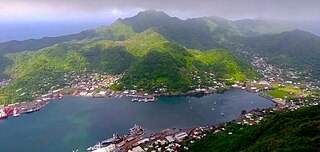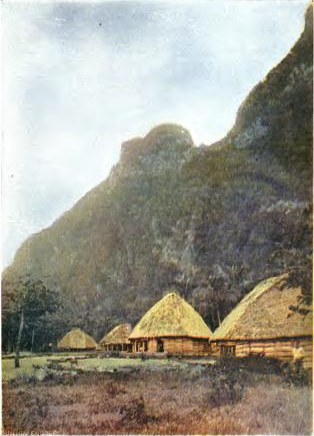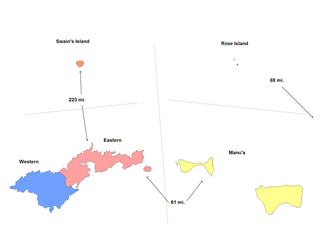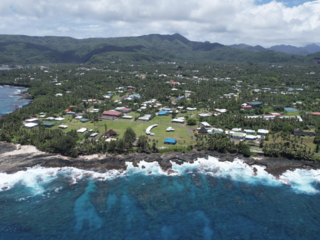Related Research Articles

The Samoan Islands were first settled some 3,500 years ago as part of the Austronesian expansion. Both Samoa's early history and its more recent history are strongly connected to the histories of Tonga and Fiji, nearby islands with which Samoa has long had genealogical links as well as shared cultural traditions.

Pago Pago is the capital of American Samoa. It is in Maoputasi County on Tutuila, which is American Samoa's main island.

Tutuila is the largest and most populous island of American Samoa and is part of the archipelago of the Samoan Islands. It is the third largest island in the Samoan Islands chain of the Central Pacific. It is located roughly 4,000 kilometers (2,500 mi) northeast of Brisbane, Australia and lies over 1,200 kilometers (750 mi) to the northeast of Fiji. It contains a large, natural harbor, Pago Pago Harbor, where Pago Pago, the capital of American Samoa, is situated. Pago Pago International Airport is also located on Tutuila. The island's land expanse is about 68% of the total land area of American Samoa. With 56,000 inhabitants, it is also home to 95% of the population of American Samoa. The island has six terrestrial and three marine ecosystems.

The Tripartite Convention of 1899 concluded the Second Samoan Civil War, resulting in the formal partition of the Samoan archipelago into a German colony and a United States territory.

The Manuʻa Islands, or the Manuʻa tele, in the Samoan Islands, consists of three main islands: Taʻū, Ofu and Olosega. The latter two are separated only by the shallow, 137-meter-wide Āsaga Strait, and are now connected by a bridge over the strait. The islands are located some 110 kilometers east of Tutuila and are a part of American Samoa, an unincorporated territory of the United States. Their combined area is 56 square kilometers, and they have a total population of 1,400. Taʻu is the largest of these islands, with an area of 44 km2 (17 sq mi), and it has the highest point of the Manuʻa, at 931 meters. Politically, the islands form the Manuʻa District, one of the three administrative divisions of American Samoa.

Tui Manuʻa Elisara was the last Tui Manu'a titleholder in Manu'a, which is now part of the U.S. Territory of American Samoa. Elisala was the son of Tui Manuʻa Alalamua whose genealogy descended from the Sa Tagaloa.

The islands of Samoa were originally inhabited by humans as early as 1000 BC. After being invaded by European explorers in the 18th century, by the 20th and 21st century, the islands were incorporated into Samoa and American Samoa.

Pago Pago AS 96799 is the downtown area of Pago Pago. Located in the low grounds at the foot of Matafao Peak, it was the location of the first American settlement on Tutuila Island. It includes the sub-village of Malaloa. Today, Fagatogo is the government, commercial, financial, and shipping center of Tutuila. It is also the administrative capital of American Samoa. It is the location of the American Samoa Fono (legislature), and is listed in the Constitution of American Samoa as the territory's official seat of government. Its population is 1,737.

Benjamin Franklin Tilley was an American Naval officer who served from the end of the American Civil War through the Spanish–American War. He was the first acting governor of American Samoa as well as the territory's first naval governor.

The Eastern District is one of the primary districts of American Samoa. It consists of the eastern portion of Tutuila, American Samoa's largest island, plus the island of Aunu'u. The district has a land area of 67.027 km2 and a 2010 census population of 23,030. It contains 34 villages plus a portion of Nuʻuuli village. Among these are Pago Pago, Fagatogo, and Utulei.
The Constitution of American Samoa is the constitution that defines the government of American Samoa. Unlike constitutions of a state, it is subject to unilateral change by the federal government. Constitutional documents of the territory include the treaties that created it and the 1960 constitution approved by the federal government and popular referendum.

Leone is the second-largest city on Tutuila Island's west coast. The village is on the south-west coast of Tutuila Island, American Samoa. Leone was the ancient capital of Tutuila Island. Leone was also where the Samoan Islands’ first missionary, John Williams, visited on October 18, 1832. A monument in honor of Williams has been erected in front of Zion Church. Its large church was the first to be built in American Samoa. It has three towers, a carved ceiling and stained glass. Until steamships were invented, Leone was the preferred anchorage of sailing ships which did not risk entering Pago Pago Harbor. Much early contact between Samoans and Europeans took place in Leone.
The following table indicates the party of elected officials in the United States insular area of American Samoa:

American Samoa is an unincorporated territory of the United States located in the Polynesia region of the South Pacific Ocean. Centered on 14.3°S 170.7°W, it is southeast of the island country of Samoa, east of the International Date Line and the Wallis and Futuna Islands, west of the Cook Islands, north of Tonga, and some 500 kilometers (310 mi) south of Tokelau. American Samoa is the southernmost territory of the United States, situated 2,200 miles southwest of the U.S. state of Hawaii, and one of two U.S. territories south of the Equator, along with the uninhabited Jarvis Island.

The title Tui Manuʻa was the title of the ruler or paramount chief of the Manuʻa Islands in present-day American Samoa.
The Treaty of Cession of Manuʻa, also known as the Deed of Cession of Manuʻa, was a treaty between Tui Manuʻa Elisala and the United States signed on 16 July 1904 that ceded the islands of Manuʻa to the United States, which now forms part of American Samoa. It came about because of the Second Samoan Civil War and the Tripartite Convention of 1899 between the United States, the United Kingdom, and the German Empire. It was ratified by the United States Congress by the Ratification Act of 1929.
The Ratification Act of 1929 was a joint resolution of the United States Congress that authorized the ratification of the Treaty of Cession of Tutuila of 1900 and the Treaty of Cession of Manu'a of 1904, which ceded the islands of Tutuila and Manu'a, respectively, to the United States and now form part of American Samoa. As such it is one of the basic Constitutional documents of American Samoa. These agreements came about because of the Second Samoan Civil War and the Tripartite Convention of 1899 between the United States, the United Kingdom, and the German Empire.

Vailoatai is a village in southwestern Tutuila, the main island of American Samoa. It is located on the eastern end of Leone Bay. The village is known for its beautiful malae, nested along the island's rugged southern coast and lined by the fale tali mālō of its village chiefs.
Taliutafa Christopher Leiesilika Young, also known as Christopher Taliutafa Young, Chris Young or Kilisi Young was the last claimant to the traditional title Tui Manu'a of Manu'a, a group of islands in the eastern part of the Samoan Islands. He was deposed from this title and exiled by American Governor Edward Stanley Kellogg because the idea of monarchy was incompatible with the Constitution of the United States.

American Samoa consists of a group of two coral atolls and five volcanic islands in the South Pacific Ocean of Oceania. The first permanent European settlement was founded in 1830 by British missionaries, who were followed by explorers from the United States, in 1839, and German traders in 1845. Based upon the Tripartite Convention of 1899, the United States, Great Britain, and Germany agreed to partition the islands into German Samoa and American Samoa. Though the territory was ceded to the United States in a series of transactions in 1900, 1904, and 1925, Congress did not formally confirm its acquisition until 1929. American Samoans are non-citizen nationals of the United States. Non-citizen nationals do not have full protection of their rights, though they may reside in the United States and gain entry without a visa. Territorial citizens do not have the ability for full participation in national politics and American Samoans cannot serve as officers in the US military or in many federal jobs, are unable to bear arms, vote in local elections, or hold public office or civil-service positions even when residing in a US state. Nationality is the legal means in which inhabitants acquire formal membership in a nation without regard to its governance type. Citizenship is the relationship between the government and the governed, the rights and obligations that each owes the other, once one has become a member of a nation.
References
- ↑ "Cover of the Tutuila Deed of Cession. 1 pg. Deed of Cession in English 4 pgs. Deed of Cession in Samoan 4 pgs. Certificate of Interpretation. 1 pg. · American Samoan Digital Archives". asamoandigitalarchives.omeka.net. Retrieved 2024-06-04.
- ↑ Stevenson, Robert Louis (1996-05-01). A Footnote to History: Eight Years of Trouble in Samoa.
- ↑ Stevenson, Robert Louis (1996-05-01). A Footnote to History: Eight Years of Trouble in Samoa.
- ↑ "GI MALALA and PULU TALALOTU (for the Mauga family and Gi family) v. AMERICAN SAMOA GOVERNMENT". American Samoa Bar Association. 17 October 2001. Archived from the original on 10 January 2020.
- ↑ Stoler, Ann Laura and Willy Brandt (2006). Haunted by Empire: Geographies of Intimacy in North American History. Duke University Press. Page 88. ISBN 9780822337249.
- ↑ "Director's Message April 19, 2024 | VA Pacific Islands health care". Veterans Affairs. 2024-04-19. Retrieved 2024-06-05.
- ↑ Leibowitz, Arnold (1980-01-01). "America Samoa: Decline of a Culture". California Western International Law Journal. 10 (2). ISSN 0886-3210.
- ↑ "American Samoa Ceded to the U.S. | Mystic Stamp Discovery Center". info.mysticstamp.com. 2022-04-17. Retrieved 2024-06-05.
- ↑ "American Samoa | U.S. Department of the Interior". www.doi.gov. 2023-03-23. Retrieved 2024-06-05.

